With so many people trying the plant-based diet, I wanted to make sure we have a great meat alternative to reference as an option for recipes. Luckily, this vegan grain meat grind recipe was in our recipe queue. It’s a versatile vegan “ground meat” that was created by Tommy McDonald, the Head Chef of Field Roast – the vegan “meat” experts!
This ground meat is a workhorse for us here at Field Roast, and is the base for many of the recipes in this book. The reason I get so jazzed about our grind is that we use a double cooking process, which makes for a really tender, chewy texture that’s just begging to be folded into your favorite recipes at home. Essentially, the mixture is cooked for the first time while you’re making the meat grind, and for the second time in the recipe you ultimately use it in (meatloaf, roasts, sausages, etc.).
This grain meat grind recipe is a sample from Chef Tommy McDonald’s cookbook, Field Roast: 101 Artisan Vegan Meat Recipes to Cook, Share, and Savor.
Homemade Vegan “Ground Meat” from the Experts (Easy Step by Step)
The recipe might look daunting at first, but Chef Tommy McDonald breaks it down with detailed instructions. And once you get the hang of it, it’s really just a few simple steps to make! Here it is in pictures:
Combine 4 Simple Ingredients.
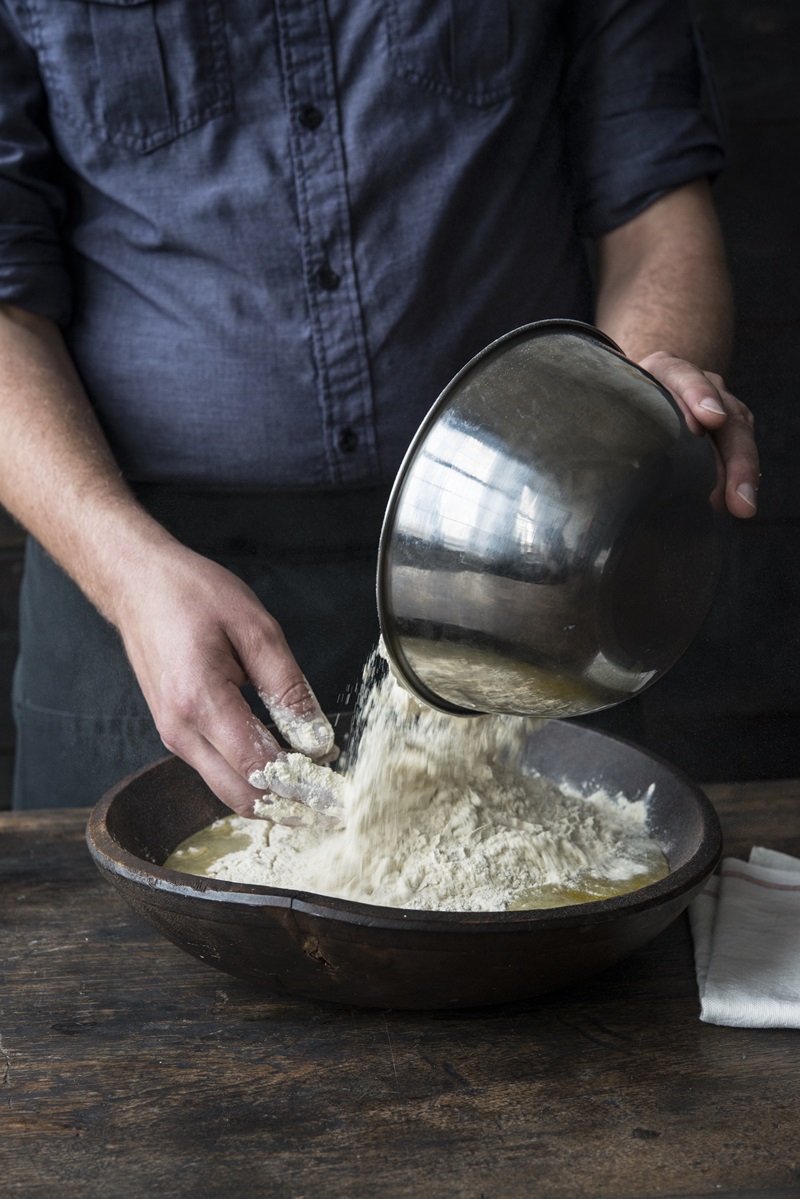
Bring the Ingredients Together with Your Hands into Dough.
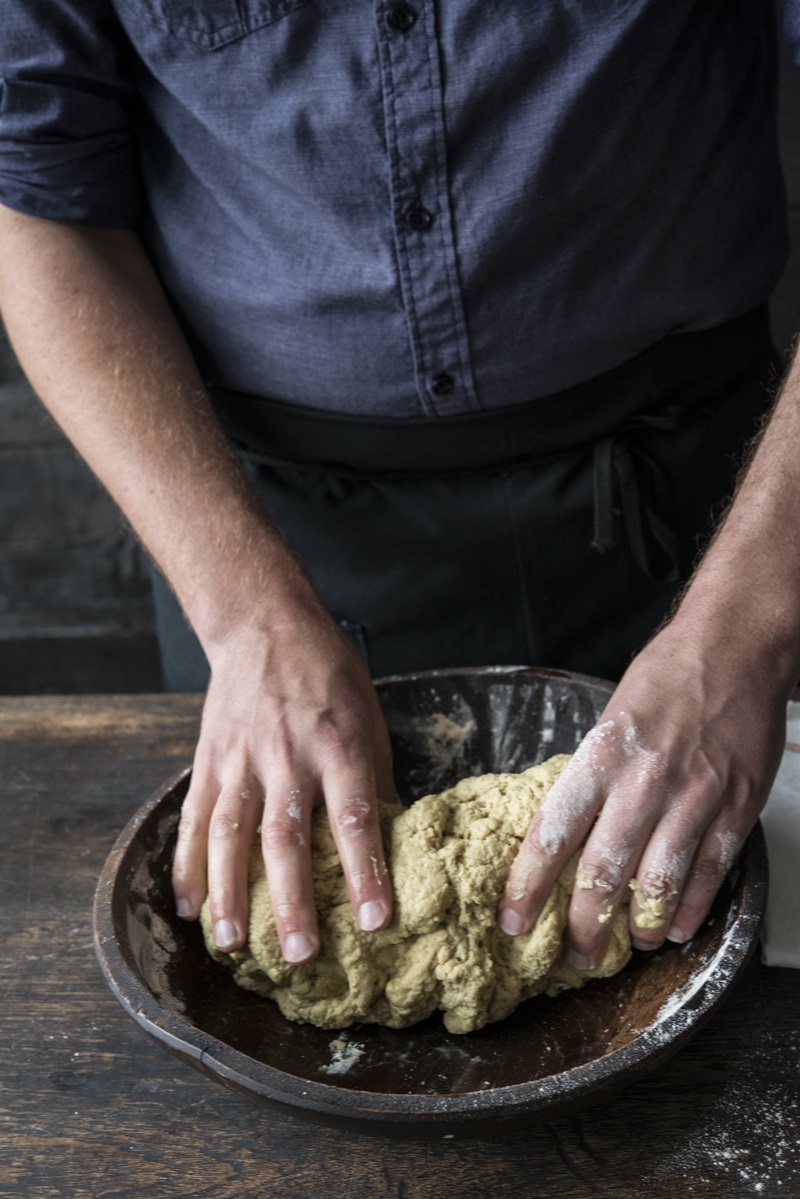
Wrap the Dough in Cheesecloth and Twine, and Submerge in Water to Cook.
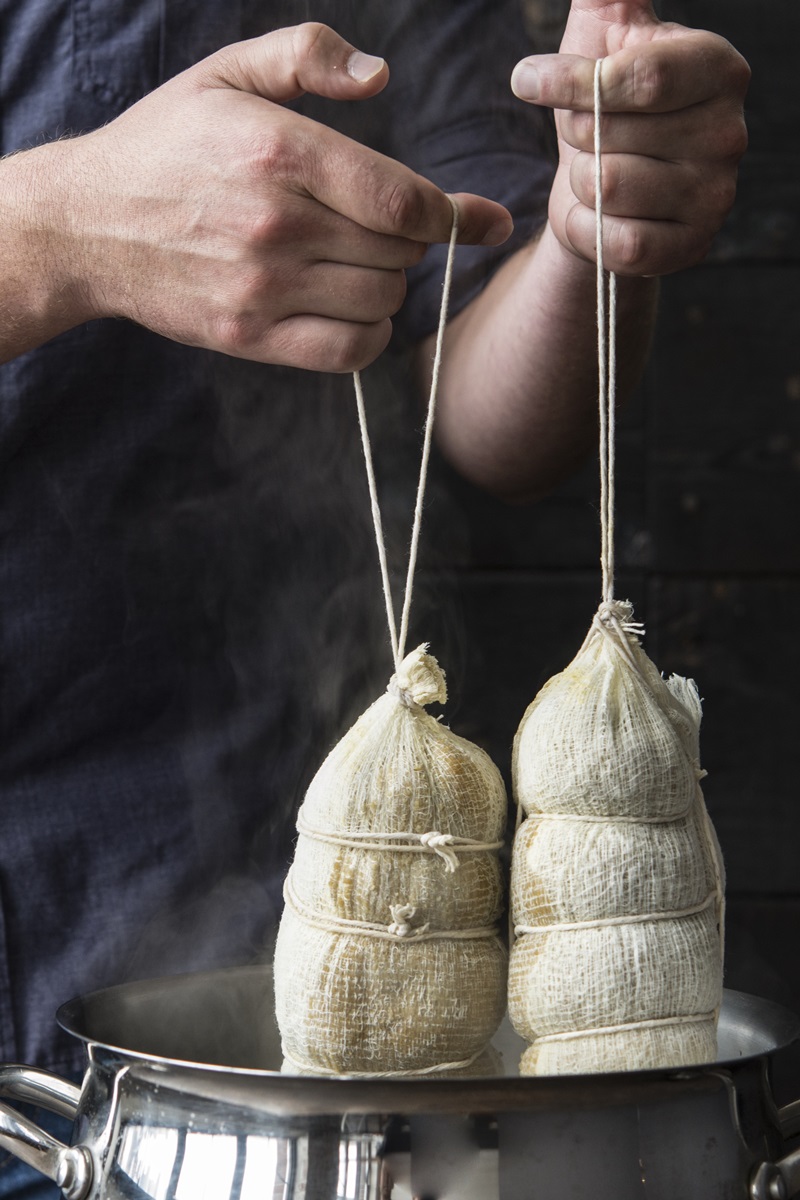
Grind in a Meat Grinder OR Food Processor.
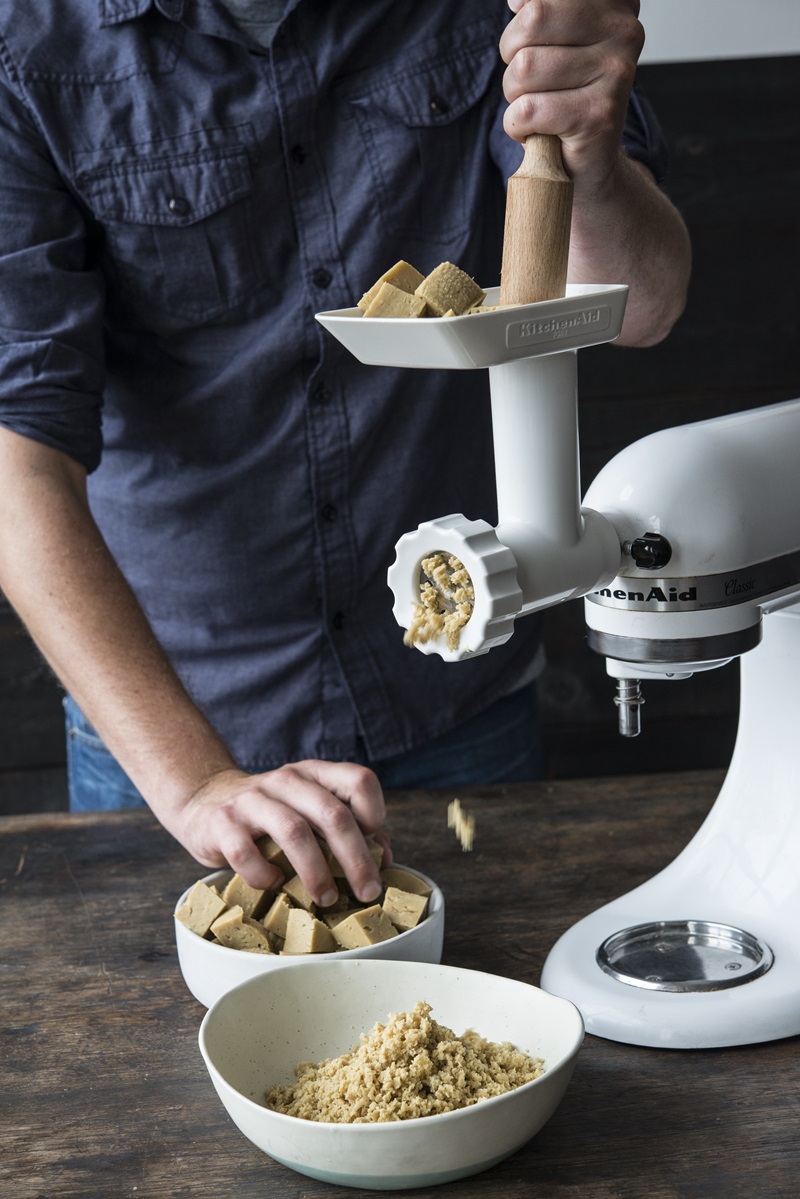
It can then be used in all types of recipes, from dairy-free lasagna to vegan “meatloaf.” You can even make a big batch to freeze and defrost as much as you need. Just keep in mind that it is a “ground meat” intended to be used in recipes, not eaten straight up. Cook it with your favorite taco seasonings or bake it in a casserole, as examples.
Salt Note for this Grain Meat Grind
I contacted Field Roast since some concern was expressed about the amount of salt and the saltiness. Here is what they said:
- The grind is not meant to be consumed alone, it is a subrecipe for sausages/burgers/meatloaf.
- The amount of salt and sodium from the vegetable base is spread across nearly 4 lbs of roast.
- Most importantly, the roasts are boiled in water, in cheesecloth, for about 90 minutes. The water does leech a good amount of salt from the grind logs (diffusion), which is why we add additional salt to the recipe. Alternatively, you could add half the salt to the water and half to the grind.
Nevertheless, you can start with less salt, if you are concerned about the saltiness.
Field Roast: 101 Artisan Vegan Meat Recipes
The Field Roast Cookbook isn’t brand new. It came out about a year and a half ago. But good recipes are timeless, and this beautiful, full color, hardcover collection is practically a must if you are interested in plant-based alternatives. It includes everything from making vegan charcuterie to classic brunch dishes and comfort food dinners. And there are ample tips and notes to ensure great results.
The collage below provides a mere taste of the recipes in the Field Roast Cookbook. The images include Chicken Fried Field Roast and Waffles, Leek Dumpkings in Dashi, Fennel and Garlic Ground Sausage, and Paella with Oaxacan Chili-Spiced Sausage .
(Please Note: I don’t recommend this cookbook if you are gluten-free. They are the grain-meat experts, so a lot of the recipe do use gluten.)
Special Diet Notes: Vegan Grain Meat Grind
By ingredients, this recipe is dairy-free / non-dairy, egg-free, nut-free, peanut-free, optionally soy-free, vegan, plant-based, and vegetarian.
- 3¾ cups cold water
- ½ cup vegetable or vegan chicken base
- 4 cups vital wheat gluten
- 3 tablespoons sea salt (see Editor's Note below)
- 2 (24 x 18-inch) pieces cheesecloth, each folded in half to make a 12 x 18-inch piece
- Safflower or canola oil spray
- 8 feet butcher’s twine
- In a large container, combine the cold water and base. In a mixing bowl, stir together the vital wheat gluten and salt, then add the base mixture, mixing until combined. You may need to use your hands to bring everything together. This dough should look a little rough and may have a small amount of excess liquid in the bowl.
- Divide the dough into two equal parts. Roll each half into a log about 8 inches long.
- Lay out the cheesecloth on a clean counter or cutting board. Spray with oil and place each roll onto its own piece of cheesecloth. Wrap the cheesecloth around the roll. Cut four pieces of twine, two about 10 inches long, the other two 18 inches each. Twist one end of the cheesecloth to make it tight against the roll, and tie this off with a double knot, using a 10-inch piece of string. Push in the roll on the untied end, and twist the cheesecloth until the roll is snug. Tie this off, using an 18-inch piece of string with a double knot, tying off a loop at the end to use as a handle. Tie the other roll in the same manner. Cut the remaining piece of string in half (you will have two 20-inch pieces of string). Tie each roll with string equidistant intervals down the roast, using a slipknot.
- In a large stockpot, bring 4 quarts of water to a boil. Holding the tied-off ends, gently slip the rolls into the water. Allow to come back to a boil, lower the heat to medium, and allow to simmer for about 1½ hours, or until internally it reads 195°F on an instant-read thermometer.
- Remove each roll from the water and allow to cool enough to handle. Using scissors, cut away the twine and cheesecloth and discard.
- Cut each loaf into 1-inch cubes. Run the cubes through meat grinder or meat grinder attachment (see Meat Grinder alternative below).
- The rolls can be stored in a gallon-size resealable plastic bag in the freezer, or can be ground immediately to use in recipes.
Chef's Note: When you first mix the ingredients together, do so with a spoon, but then feel free to dive in with your hands and get messy—it’s simply easier to incorporate all the ingredients this way. The first time you make the meat grind, you’ll likely feel like there’s way too much water in the bowl, but don’t worry:
the gluten will absorb the liquid as it sits and you’ll soon be left with a nice, uniform dough. If you do end up having excess moisture in the bowl, you’ll just lift out the dough and leave it behind—nothing to worry about.
No Meat Grinder? No Problem: I realize that a meat grinder isn’t exactly a mainstay in most home kitchens, so a good hack here is to use your food processor to grind the grain meat. To do so, slice up your meat into roughly 1-inch cubes and divide them into two groups. Because you want some differently sized bits in your grind for optimal texture, you’re going to process one group into more of a fine grind (resembling, say, orzo pasta) and the other into more of a coarse
grind (resembling a small bean). Once the meat is processed, you’ll go ahead
and mix both grinds together into a big bowl, and you’re ready to roll.
This recipe is reprinted with permissions from Field Roast: 101 Artisan Vegan Meat Recipes to Cook, Share, and Savor by Tommy McDonald.
Key Pantry Supplies: Vegan Grain Meat Grind



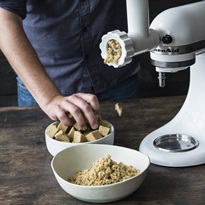
11 Comments
Alisa,
Have you made this recipe? It comes out 7 times as salty as their store product. Do the math on the vegetable base, sea salt, etc. I can testify this is too much. My wife and I made it and gagged on the level of salt. After making this sodium heavy grind, they say to use 3 cups of about 9 made and add another 2 tbsp of base and 3 tsp of sea salt.
Something in here is a typo. Withholding sea salt from all recipes still gives you over 700mg of sodium per serving, twice their store products.
Hi Mike, the recipe was shared with us by the founder of Field Roast, I do not make all contributed recipes for dietary reasons in our own household. I did double check and it is accurately reprinted from the book. But this does seem like an excessive amount of salt, I agree. I calculated the equivalent, and added an Editor’s Note to the recipe regarding the salt with recommended amounts. Based on the sodium levels of Field Roast ground meat and sausage, the added sea salt is unnecessary or too high, depending on the brand of base you use. I’m not sure if they used this amount in order to tenderize the gluten, or for taste preferences. I am following up with Field Roast but this past year has been a hard time for getting responses! Nonetheless, I am sorry that it didn’t work out well for you, as I realize this is a time-consuming recipe. Your feedback is appreciated so that we can give a heads up to other readers who want to make their own grain meat!
For the recipe it calls for a half cup of vegan chicken base. Does that really mean an entire container of better that bouillon? Or is a half cup of the stock? I saw the one you linked to, and it seems along the lines of BTB. The cookbook doesn’t make this aspect quite clear and I’d love some clarification.
Hi Peyton, I’m pretty sure it is 1/2 cup of the actual base. This makes a lot of meat alternative – 3 1/2 pounds. You can half the recipe if you don’t want to commit to that much. That would be 1 3/4 cup + 2 tablespoons water, 1/4 cup base, 2 cups wheat gluten, and 1 1/2 tablespoons salt. And you would only need one piece of cheesecloth to make one log.
Thank you for the clarification Alisa! Very helpful.
It also says to “discard the cheese cloth”. Discard, like through away? Can’t it be washed and reused? Seems like an awful waste. Is there an alternative to cheesecloth, like perhaps parchment/baking paper?
Some people do rewash and use cheesecloth. It just depends on how weak it has become from use and the quality of the cheesecloth. I use it to make cheese alternatives, and have found that it isn’t reusable, but I buy the cheap stuff!
Based on the ingredient list and technique this doesn’t look very good. Vital wheat gluten recipes often need chickpea flour to combat the rubberyness that VWG is notorious for. Also, VWG also has a very strong flavor and a couple cups of stock is not going to overcome that.
They sell A LOT of grain “meat,” and it’s pretty tasty! So I trust their formula 🙂 I’ve used vital wheat gluten quite a bit, and don’t find it to have a strong flavor unless rancid. Wheat flour and wheat protein can go rancid pretty easily at room temperature, especially in dry climates. I usually store it in the freezer to avoid this and keep the flavor very mild. The recipe is quite easy and relatively inexpensive, so hopefully you get the chance to try it for yourself and see!
I own their cookbook and this recipe isn’t supposed to be eaten by itself. It is supposed to be used as the base of other recipes. So you take this meat grind once cooked, then mix in other raw VWG and a bunch more seasoning stuff and cook it again. The two stage cooking creates a better texture for things like sausage. So yeah, this stuff isn’t the best stand alone recipe, but it isn’t meant to be.
Thank you for pointing this specific out Maddie. I hadn’t considered that some people might not be cooking it with their recipe and will add that note.